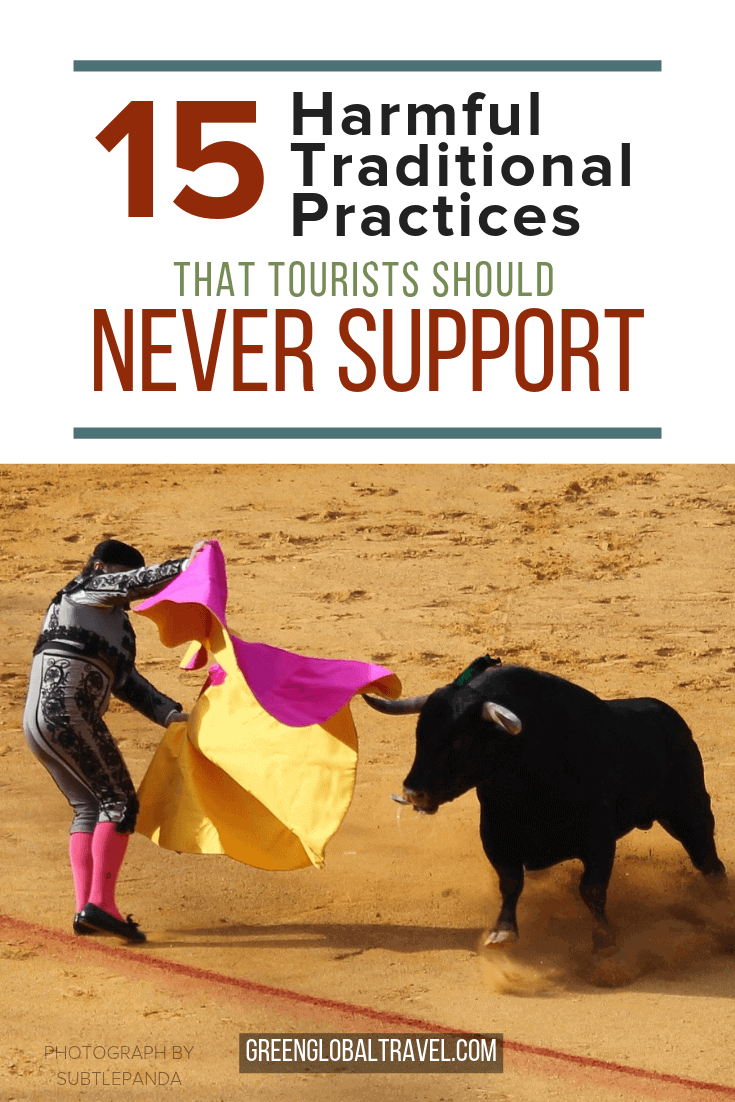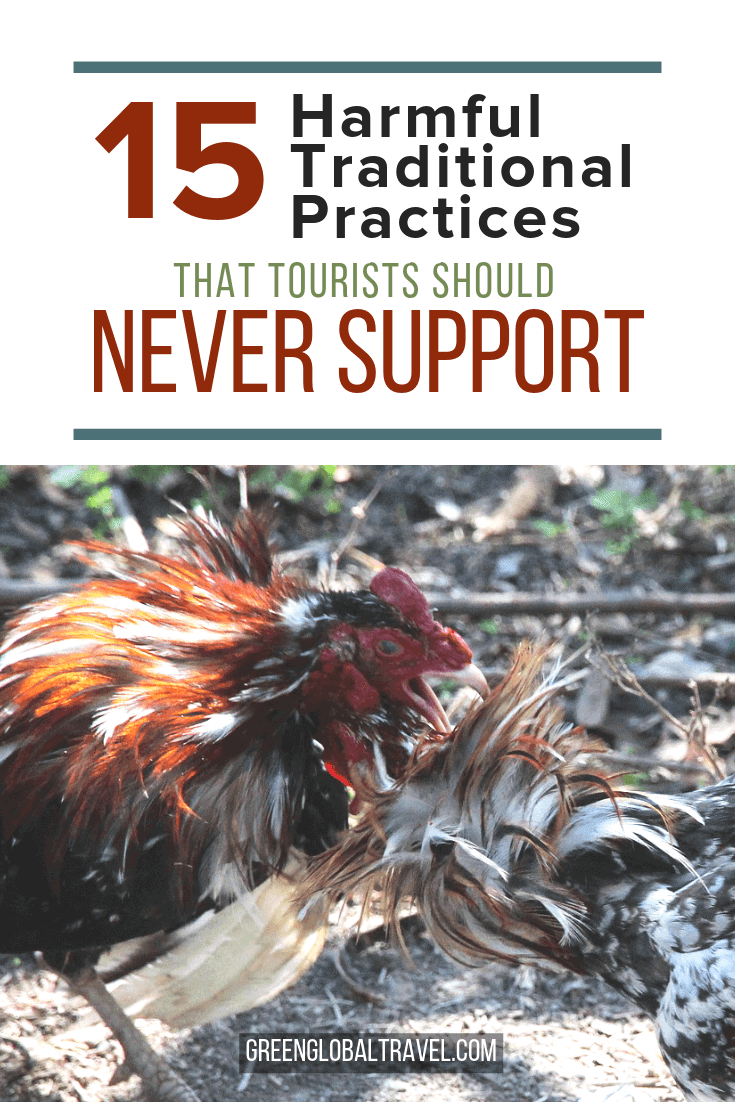In the last few decades, as international travel has gotten exponentially easier and animal rights issues more pervasive, harmful cultural practices have come to the forefront of travel concerns.
Many traditional practices rooted in indigenous culture and antiquated lifestyles have been exploited for the tourist revenue. While established rituals remain important, times do change as mankind evolves. And with them, so does the world.
There are many aspects of the “days of yore” that truly deserve to be preserved for future generations. There is a lot we can learn, for instance, from traditional shamanic healing practices and sustainable agriculture techniques.
But at the same time we must collectively make continual progress towards creating a more just and responsible world, not just for humans but for animals as well.
While traveling, we often face choices that test our own resolve: Do we accept local customs that are in direct disagreement with our own beliefs? Or do we reject unethical acts outright, even though they may be examples of traditional cultural practices in the region?
Like many aspects of responsible travel, it’s a tough tightrope to walk. What follows are 15 cultural practices we believe tourists should never support, and which we hope will eventually go the way of the Dodo.
READ MORE: 40 Green Travel Tips (Ultimate Guide to Sustainable Travel)
15 HARMFUL TRADITIONAL PRACTICES TO AVOID
- Bullfighting
- Bear Baiting
- Rooster Fighting (Cockfighting)
- Shark Soup
- Turtle Eggs & Turtle Meat
- Elephant Rides
- Buying Ivory Jewelry
- Souvenirs made from Animals
- Fox Hunting
- Circus Animals
- Running of the Bulls
- Tiger Temples & Tiger Petting
- Swimming with Dolphins
- Walking with Lions
- Shark Chumming or Baiting

Why Are Cultural Practices Important?
Traditions and cultural practices are things we always enjoy experiencing in our travels. They’re what makes each of the places we visit utterly unique. They’re the fabric that creates the diverse tapestry of the world we have today, defining the local communities that celebrate them.
There are so many examples of traditional cultural practices around the world, from acts as small as shaking hands to things such as white dresses at wedding ceremonies. They are tied into the way we eat, the types of homes we live in, and the deities we worship.
Our culture is sometimes so ingrained in us that it feels almost intrinsic to our humanity. And for the most part, we as travelers should celebrate these idiosyncrasies of people and place. They’re a big part of what makes world travel so interesting.
However, there are many harmful practices and traditions that have not withstood the test of time when it comes to adapting to the responsible ecotourism ethos.
These days, the exploitative nature of mass tourism is becoming an increasingly big problem in destinations all around the world. From elephant rides and swimming with dolphins to all sorts of irresponsible animal selfies, there’s always some entrepreneurial soul (or corporation) willing to sacrifice ethics for profits.
As travelers who yearn to be responsible in our choices, it’s good to be informed about the types of tours and experiences we sign up for.
READ MORE: Maasai Mara Conservancies (Community Conservation in Kenya)
15 Harmful Traditional Practices to Avoid
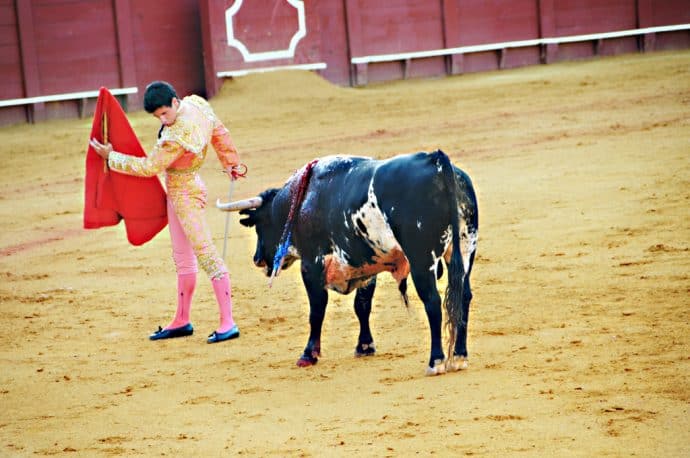
1. The Cruelty of Bullfighting
Bullfighting is cruel because an animal—the bull—is essentially tortured to death for the audience’s amusement. Bullfighting is all about spectacle.
Some argue that the tradition of bullfighting allows matadors to display great skill and take valiant risk, justifying the brutality as a thing of beauty. But that point of view is dying the same slow death bulls do, pierced by one stiff stance at a time.
The history of bullfighting in Spain dates back to Moorish tradition in the AD 700s, which they carried over from the Visigoths they conquered. People rode on horseback to kill bulls for a feasting ritual. They were aided by brightly clothed men, who eventually became matadors.
Nowadays, a group of men led by a matador enter a ring and slowly kill a bull by stabbing it with swords in an attempt to enrage it. The typical corrida (fight event) sees six bulls in bullfighting, who are killed by three different matadors.
In other words, the real bullfighting facts are that the animal is outnumbered, the men all have swords, and the bleeding bull is forced into a battle it wants no part of. This practice stands in stark contrast to the increasingly popular cultural tradition of treating animals humanely.
READ MORE: The Best Things to Do in Spain (For Nature Lovers)

2. Bear Baiting in Pakistan
If you think bullfighting is bad, wait until you hear about a favorite pastime in rural Pakistan sports: bear baiting. Long snubbed by animal rights activists as barbaric, this inhumane bloodsport pits bears vs dogs in brutal fights that often result in death.
As with the bulls, this “bear fight” is designed to be fair. Young bears are captured in the wild at an early age, and they’re put through immense pain long before the first fight. Their canine teeth are broken, their muzzles are painfully pierced with nose rings (to which chains are attached), and their claws are often removed.
With none of their natural weapons at their disposal (save strength), the dogs (usually a pack of them) attack it mercilessly as a cheering crowd eggs them on. The bear’s suffering is intense, and most die from their injuries before they reach the age of eight.
A bear fighting dogs in this setting serves no humane purpose. While it may be a traditional Pakistan sport, the event is nothing more than entertainment for cruel-hearted people.
In our eyes, this ranks right up there alongside bear bile farming among the most brutal cultural practices these awesome ursine creatures are forced to endure.
READ MORE: 40 Facts About the Markhor (National Animal of Pakistan)
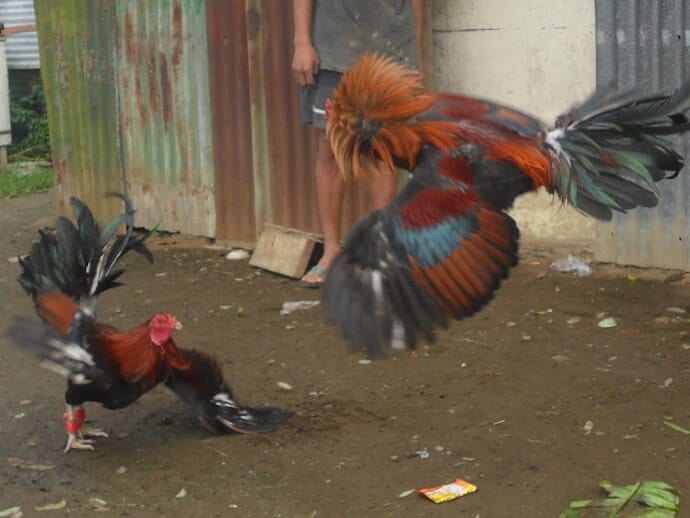
3. Rooster Fighting (a.k.a Cockfighting)
Pakistan is not alone in pitting animals against each other for the sake of entertainment. Though banned in all 50 US states, cockfighting is still practiced in many communities here, as well as throughout Latin America and in Southeast Asia (including the Philippines and Indonesia).
Rooster fighting consists of putting two roosters, who are bred and trained specifically to be aggressive, going beak to beak in a ring. They often fight to the death.
In other words, the so-called “game” of cockfighting is hardly that. It’s a matter of life or death for human (and inhumane) amusement.
Breeders also pump the birds up on steroids and vitamins, as well as put them through odd training for the rooster fights. Before matches, birds’ feathers are plucked and their wattles removed so that their opponents can’t rip them out. Then, in the ring, roosters will sometimes wear blades on their legs in order to make their attacks even more brutal.
Historically, rooster fighting is linked with other crimes, like gambling, drugs, and violence. In other words, it may have been around a long time, but that doesn’t mean it’s a tradition to uphold.
READ MORE: 15 Beautiful Galapagos Birds

4. The Sad Truth Behind Shark Soup
Ours is a funny old world. The closer we study it, the more we notice that men were obsessed with obtaining extra oomph in the bedroom long before Viagra came along. There has also been a historical display of wealth that often crossed the line into wasteful.
Shark soup– which has long been a symbol of status and generosity in Asia– can pull in a price of $2000 a bowl (depending on the type of shark).
But the shark fin used to make this weird delicacy has no nutritional value or impact on flavor, which is provided by chicken and ham broth.
The shark finning facts and figures are startlingly ugly. More than 100 million sharks are illegally poached for shark fin soup every year. This typically consists of slicing off the animal’s fins while it’s still alive, then tossing their bodies into the water to die a slow, painful death.
So, it’s no great surprise that there has been great effort to stop the harmful tradition. Nevertheless it persists, and eating this soup is a cultural practice travelers should take part in.
READ MORE: Saving Asian Animals (The 10 Best Conservation Programs)
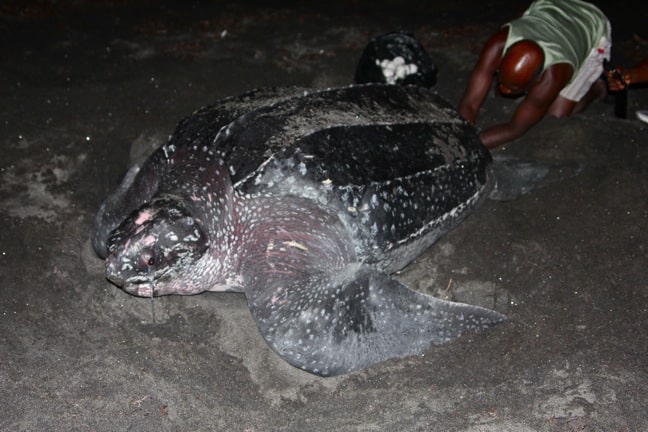
5. Poached Turtle Eggs & Turtle Meat
Sea Turtle eggs are similarly prized as an aphrodisiac in some parts of the world, and Sea Turtle meat is considered a delicacy for many cultures.
Despite being endangered and protected by the law, Sea Turtle eggs are often sold on the black market. The ultimate extinction of some species (including Leatherback Sea Turtles and Kemp’s Ridley Sea Turtles) seems inevitable, yet still sales continue.
On the Caribbean coast of Costa Rica, poachers are so aggressive that they murdered local activist Jairo Mora as he tried to protect nests on Moín Beach.
Beyond what this says about humankind’s me-first mentality, these irresponsible practices have now put many species at serious risk of disappearing completely. In our eyes, cultural traditions that threaten the future shouldn’t be upheld.
As responsible tourists, we shouldn’t be eating Turtle eggs, and we shouldn’t eat Turtles. We should never order any food that puts a wildlife species at risk of extinction.
READ MORE: Searching for Sea Turtles on Masirah Island, Oman
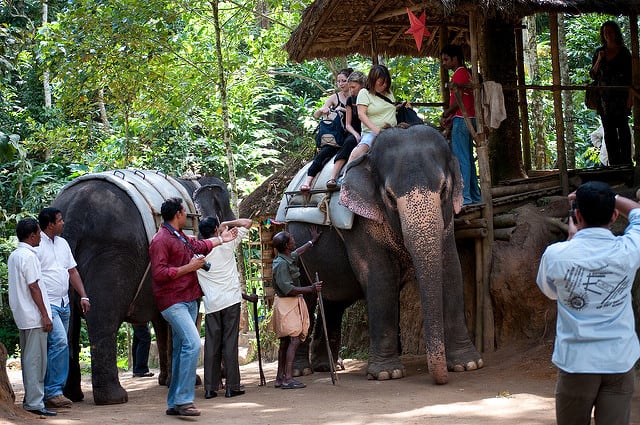
6. Why Elephant Rides Are Abusive
Sometimes it’s confusing to be enamored with animals and long for interaction with them, yet realize that the best thing we can do as conscious travelers is to leave them alone.
Elephant rides are one of the most common irresponsible choices made by people traveling abroad. Riding Elephants is usually on offer at major tourist venues in Thailand, Indonesia, and myriad other parts of Asia. There are even Elephant trekking tours available.
But the ugly truth about Elephant riding is that the animals are commonly abused for tourist entertainment, often at the painful end of electric prods or bull hooks.
A brutal training regimen known as phajaan (which originated with people riding Elephants in India) takes young Elephants away from their mothers, then violently crushes their spirit until they’re submissive.
Though they’re super-strong, these gentle giants are not built to carry weight around on their backs all day long.
While Elephants continue to be used as beasts of burden in Asia, the damaging effect on their health far exceeds levels of acceptability. These inhumane practices may be considered tradition in certain cultures, but please don’t contribute to the abuse.
READ MORE: 55 Interesting Facts About Elephants

7. Buying Ivory Jewelry & Other Ivory Products
Souvenirs are often a highlight of our travels, serving as both a treasured keepsake and a means of sharing our adventure with those back home.
But in the frenzy to buy something unique, it’s easy to lose sight of right and wrong. These days, the poaching-for-ivory trade is causing serious environmental issues.
Animals with ivory tusks/teeth include Elephants, Walruses, Hippos, and Narwhals. At one time these tusks were traded amongst indigenous people, who depended on these animals for survival. Then the demand for ivory grew so large that traditional custom gave way to commerce.
In places like South Africa and Tanzania, wildlife populations have plummeted as a result of poaching. The international ivory trade is now completely illegal. So no matter what greedy vendors might tell you, that ivory jewelry is something to skip out on.
READ MORE: Animals in Kenya (40 Species of Kenyan Wildlife)
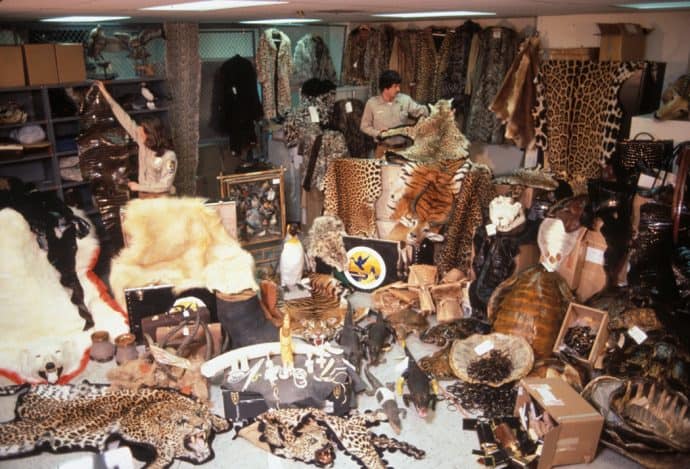
8. Other Souvenir Items Made From Animals
Travelers on the whole need an overall improvement in awareness about the souvenir items we buy. There are many products made from parts animals that are protected (or should be).
Many furs and animal skins are illegal. Turtle shells and Tortoise shells are all off-limits. The safest policy for travel souvenirs is to stay away from all wildlife products, period.
Coral is another major issue, as there are many endangered coral reef systems being exploited for profit. But some unscrupulous vendors are still selling coral jewelry, coral ornaments, and other coral gifts to tourists.
Even if you see dead coral on the ocean floor while Scuba diving, it should be left in the sea.
While some of these items may still be used in local indigenous cultural practices, they have no place in international travel.
READ MORE: Scuba Diving the Belize Barrier Reef

9. Fox Hunting in the UK
Fox hunting in the UK has an extensive history, both in the upper-crust enjoyment of the sport and in the public push to have it banned. Eventually, the House of Commons passed a Fox hunting ban. But persistent people have found loopholes to the law.
Regardless of what you may feel about hunting in general, hunting Foxes in this way is a uniquely vicious “sport.” A Fox is tracked and chased for hours by Fox-hunting dogs until it’s totally tuckered out. When the hounds finally catch it, it’s often ripped to shreds on the spot.
Though supporters of Red Fox hunting claim the tradition does farmers a service, the truth is that the methodology is what’s questionable about this practice. The 2004 Hunting Act made it illegal to use dogs to kill their prey. However, riders can still use dogs to track Foxes, chase them to exhaustion, and flush them out of their holes to be shot.
A simple trap would do a much more efficient and humane job of eliminating troublesome predators from a farmer’s field. History and tradition don’t make Fox hunting right, so travelers should leave this pastime for the Brits to debate.
READ MORE: Can Hunting Save the Endangered Black Rhino?
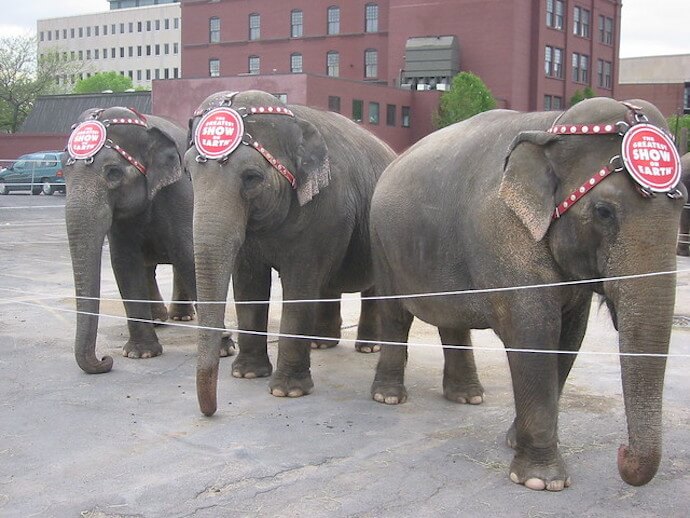
10. Circus Animals Are Abused
While many of us grew up in a world where circuses had animals and that was considered okay, these days times have changed. The world renowned Ringling Brothers elephants may have captivated our attention as kids, but the ugly truth about circus animal abuse is undebatable.
Circus animal cruelty is rampant. Over 95% percent of circus animals’ lives are spent in chains or cages, from circus Elephants and the Lions that are literally whipped into shape to dancing Bears (a Russian circus tradition). These animals travel in box cars around 11 months per year.
But the abuse doesn’t stop with travel. Training these animals typically involves severe measures. Lion taming includes whipping and shocking, and Elephant abuse is the same.
Animals are routinely hit and poked during the training process, which— let’s be frank— is just forcing animals to do tricks for meaningless applause.
Elephant cruelty, Lion abuse, and other animal mistreatments that occur under the Big Top are not acceptable. There are plenty of animal-free circuses that are every bit as amazing, if not even more so, including Cirque du Soleil, the Moscow State Circus, and Teatro ZinZanni.
READ MORE: Cirque du Soleil Founder Guy Laliberté’s One Drop Foundation

11. Running of the Bulls
Some travelers forego attending bullfights, yet participate in the seemingly more fun-loving running of the bulls. But it’s important to realize that all of the animals that participate in the Pamplona bull run are heading to their own gruesome deaths in the bullfighting ring.
Running with the bulls has become more of a tourist tradition than a local custom. The San Fermin bull run may have started as a local tradition, but it has become an extreme sport in the years since Hemingway’s The Sun Also Rises.
The reality is that people are just running with bulls in order to get them through town and into the bullfighting arena. For those who may be unfamiliar with the brutality and cruelty involved in that sport, please revisit item #1 on this list.
For those responsible travelers who visit Spain and San Fermin, the running of the bulls in Pamplona is not something to be part of. Most locals have already dismissed the custom as abusive, and it continues only through subsidies and tourist revenue.
READ MORE: 7 Reasons Responsible Tourism is Better For Everyone
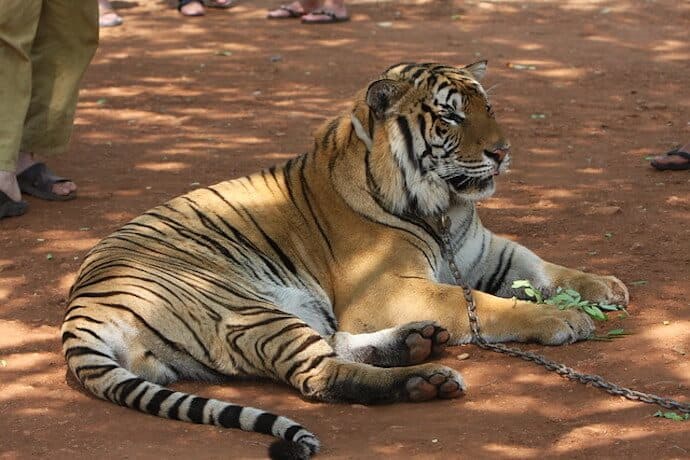
12. Tiger Temples/Tiger Petting
The infamous Tiger Temple in Thailand has now been exposed, and the reality of the tiger monastery was truly horrifying. Sightseers excited about petting Tigers had their eyes opened to the ghastly nature of irresponsible tourism.
Once one of the world’s most famous Tiger reserves, the Thai Tiger Temple was found with over 60 carcasses of Tiger cubs, Tiger pelt rugs and amulets, and Tiger teeth trinkets. With that, the moral price of a Tiger selfie came into much sharper focus: It was the animals themselves.
But the temple (which is set to reopen next door as “Golden Tiger Zoo”) was not the only Tiger farm in Thailand.
According to Time, the number of similar venues have increased in the last few years, as have the number of captive Tigers in Thailand. Other (in)famous spots include the Sriracha Zoo and Damnoen Saduak Tiger Zoo.
It’s a good idea to avoid Tiger petting zoos altogether, and there should be no place where tourists can pet a baby Tiger. It’s simply not a good environment for these endangered Indian animals.
READ MORE: The 13 Most Beautiful National Parks in Thailand

13. Swimming with Dolphins
Dolphin encounters have long been a trendy activity, but the Dolphin experience has gone too far. Rather than just spotting Dolphins in their native habitat, dolphinariums have popped up around the world to offer tourists places to swim with and even ride them.
First of all, the only humane place to swim with Dolphins is the ocean, where they naturally live. These animals don’t belong in captivity, caged in small pools for most of their life. Adding to the horror seen in environmental documentaries like The Cove and Blackfish is irresponsible.
Secondly, swimming with Dolphins isn’t actually something most of us should ever attempt. Large groups of people swimming amongst large groups of wild Dolphins isn’t really safe for the humans or the animals.
There are some tours that purport to provide this experience in the open ocean responsibly. But they also warn that swimmers need to be confident with a snorkel and realistic about the animal’s behavior. There will be no jumping through rings or dorsal fin hitchhiking allowed.
READ MORE: How to Grade Swimming With Dolphins Facilities

14. Walking With Lions Tours
Animal lovers can often be sucked into the idea of an unrealistic encounter with their favorite animals. Humans shouldn’t walk with Lions, and if they’re doing so then something is wrong.
Often promoted as an eco-friendly activity that aids in conservation efforts, walking with Lions tours have turned out to be an awful, exploitative example of greenwashing at its worst.
These tours often include cuddling and petting young Lion cubs. What they don’t tell tourists is that the baby cubs are taken from their mothers at an early age so that they can become accustomed to being nurtured by humans instead.
Once these young Lions grow too large for cuddling (usually around the age of one), their lives take an extremely dark turn. They’re usually put in cramped cages with other overgrown cubs. Then they’re sold off to canned Lion hunting operations for wealthy hunters to kill.
The short, simple truth is that dangerous wild animals are not meant to be handled by humans, and being among throngs of people is never a natural, healthy environment for them.
READ MORE: The Walking With Lions & Canned Lion Hunting Connection

15. Shark Chumming/Baiting
Another animal that many people want to see up close in the wild is Sharks.
While that often happens for those who go Scuba diving regularly, those packaged tours that promise guaranteed sightings will likely involve the use of shark chum.
Shark diving– particularly cage diving with Great White Sharks– has become a huge tourist draw in places like South Africa and Australia. But in order for cage diving tours to be successful, Sharks have to be attracted to the area.
The problem with shark cage diving is that it changes the animals’ natural behavior. Suddenly, they learn to be attracted to the sound of humans and populate areas where humans go.
This often creates undesirable interactions between hungry Sharks and surfers or swimmers. In other words, there are more Shark-infested areas and more Sharks prone to attacks.
Diving with Great White Sharks has helped a lot, from a conservation standpoint, in terms of tranforming the animals’ “killer” image. But the bad press from one attack can do much more damage than hundreds of safe dives can repair. In the end, it doesn’t work in favor of the Shark.
READ MORE: Swimming With Whale Sharks in Cancun
FAQs About Cultural Practices
1. What is an example of a Cultural Practice?
A simple cultural practice in Western countries is shaking hands when you greet one another. Other cultures bow (Japan), do nose kisses (Oman), stick out their tongues (Tibet), perform jumping dances (the Maasai people of Kenya and Tanzania), and so on.
2. Is bullfighting banned?
While bullfighting has been banned in many places, including states in Mexico and certain spots in Portugal, the practice isn’t altogether prohibited in the world. Catalonia officially banned bullfighting in 2012, but events still happen in Spain as well as parts of Mexico and other Latin American countries.
3. What is cockfighting?
Cockfighting consists of putting two roosters, which have been bred and trained specifically to be aggressive, in a ring together. They are sometimes equipped with weapons (such as razor blades) on their legs, and they often fight to the death.
4. Is it bad to ride an Elephant?
The blunt answer is yes. While it seems alluring and presumably Elephants are strong enough, the animals are not naturally equipped to carry tourists around all day long. Plus, the process of taming, training, and controlling Elephants (known as the phajaan) is abusive.
5. Where does ivory come from?
Ivory comes primarily from the tusks of Elephants, but it can also be sourced from Narwhals, Hippos’ teeth, and Walrus tusks. The fossils of Mammoths are another source of ivory used in souvenirs. –Jonathan Engels
